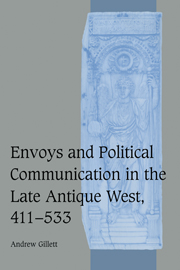Book contents
- Frontmatter
- Contents
- List of tables
- Preface
- List of abbreviations
- Chronological table
- Maps
- 1 EMBASSIES AND POLITICAL COMMUNICATION IN THE POST-IMPERIAL WEST
- 2 THE PROVINCIAL VIEW OF HYDATIUS
- 3 THE HERO AS ENVOY: SIDONIUS APOLLINARIS' PANEGYRIC ON AVITUS
- 4 THE SAINT AS ENVOY: FIFTH- AND SIXTH-CENTURY LATIN BISHOPS' LIVES
- 5 CASSIODORUS AND SENARIUS
- 6 NEGOTIUM AGENDUM
- CONCLUSION
- Appendix I Chronology of Constantius, Vita Germani
- Appendix II Chronology of the life of Epiphanius of Pavia
- Appendix III Senarius' Letters of Appointment: Cassiodorus, Variae IV, 3 and 4
- Appendix IV The text of Senarius' Epitaph
- Note on editions, commentaries, and translations of major sources
- Bibliography
- Index
- Cambridge Studies in Medieval Life and Thought Fourth series
Appendix II - Chronology of the life of Epiphanius of Pavia
Published online by Cambridge University Press: 12 July 2009
- Frontmatter
- Contents
- List of tables
- Preface
- List of abbreviations
- Chronological table
- Maps
- 1 EMBASSIES AND POLITICAL COMMUNICATION IN THE POST-IMPERIAL WEST
- 2 THE PROVINCIAL VIEW OF HYDATIUS
- 3 THE HERO AS ENVOY: SIDONIUS APOLLINARIS' PANEGYRIC ON AVITUS
- 4 THE SAINT AS ENVOY: FIFTH- AND SIXTH-CENTURY LATIN BISHOPS' LIVES
- 5 CASSIODORUS AND SENARIUS
- 6 NEGOTIUM AGENDUM
- CONCLUSION
- Appendix I Chronology of Constantius, Vita Germani
- Appendix II Chronology of the life of Epiphanius of Pavia
- Appendix III Senarius' Letters of Appointment: Cassiodorus, Variae IV, 3 and 4
- Appendix IV The text of Senarius' Epitaph
- Note on editions, commentaries, and translations of major sources
- Bibliography
- Index
- Cambridge Studies in Medieval Life and Thought Fourth series
Summary
The chronology for the life of Epiphanius offered in chapter 4 differs by one year from that of e.g. Cook and Cesa. PCBE offers a chronology similar to chapter 4, but without a full justification. The central datum in any reconstruction of the chronology of Epiphanius' life is the date of his embassy to Euric, during the reign of Nepos, in the eighth year of Epiphanius' episcopate. Cook places the embassy in spring 475 on the following basis: Nepos ruled in Italy from 19 or 24 June 474 (summer) to 28 August 475 (summer); Ennodius indirectly refers to the season during which Epiphanius undertook the embassy as spring by a passing mention of spring rains; therefore only spring 475 is possible. But the evidence in the Vita of the season in which Epiphanius undertook his embassy is very slight. In fact, as far as it goes, the text suggests summer, not spring: during stops at mansiones on the journey to Toulouse, Epiphanius regularly draws apart from his retinue to pray by himself, under the shade of trees for protection from the sun, where, prostrate on the verdant grass, his tears water the soil which is parched for want of rain. This is hardly an explicit time indicator, but it has the virtue at least of autopsy, for Ennodius accompanied Epiphanius on the journey to Toulouse. The references to the heat of the sun, the verdant grass, and the dry soil suggests the heat of summer, not the rains of spring.
- Type
- Chapter
- Information
- Publisher: Cambridge University PressPrint publication year: 2003



